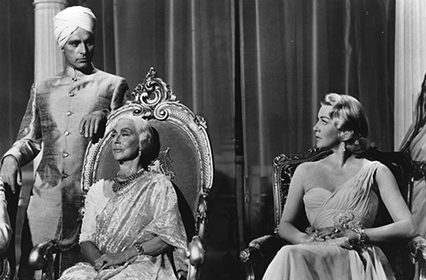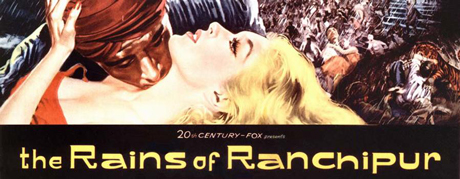
 |
|
|
|
While casting about for feature ideas for the new CinemaScope process, Fox's Darryl F. Zanuck probably decided early on to remake 1939's The Rains Came, a sultry tropical soap opera that generates real heat. Back then Fox's golden boy Tyrone Power met the challenge of playing an Indian doctor. He and married visitor Myrna Loy had such palpable chemistry that their age differential never became an issue. In addition to its exotic romance, Rains impressed audiences with a spectacular flood sequence, a show-off set piece in which half a city is wiped away when a dam breaks. One of those '30s disaster epics designed to top the earthquake in MGM's San Francisco, The Rains Came won an Oscar for its Special Effects. 1955's The Rains of Ranchipur looks like a winner, with star Lana Turner paired with Richard Burton to portray the ill-fated romance across ethnic and class barriers. The story has been tweaked to fit the new cast, and much of the dated-but-effective "oriental mystery" trappings have been supplanted by Early CinemaScope's appetite for travelogue beauty. 
The story wastes no time gathering wealthy guests at the home of the beloved Maharani of Ranchipur (Eugenie Leontovich). The unhappy Lord Albert Esketh (Michael Rennie) brings his wife Lady Edwina (Lana Turner), a thoroughly spoiled playgirl who takes up with other men to suit her whims. One of her old flames is the lapsed architect and current alcoholic Tom Ransome (Fred MacMurray). They do not resume their romance; Tom disapproves of Edwina's cruelty to her husband. Besides, Tom is just becoming aware of the amorous presence of the young Fern Simon (Joan Caulfield). The girl wants to escape her missionary parents and go to school in America, but likes Tom's company too. The Maharani becomes distressed when Edwina claims as her next lover the kindly, dedicated Dr. Major Rama Safti (Richard Burton). The old lady raised Safti from childhood and is not pleased when the selfish Edwina claims to be truly in love. She plans to take the inexperienced Safti to America with her, away from his clinic. Overwhelming these personal travails, the big dam breaks during a huge monsoon rain, destroying half of the city. Ranchipur is split in two, with Edwina on one side and Dr. Safti at his clinic on the other, trying to suppress a breakout of disease. Tom uses his skills to place a bomb to clear a waterway to allow the floodwaters to drain away. But will Safti still leave with Edwina? What about Tom and Fern? A perfectly serviceable soap opera, The Rains of Ranchipur doesn't bother to update the story in any significant way. The Maharani is still the effective civic leader and she still invites mostly important foreigners to her parties. The whites drink too much and conduct their tawdry affairs in public. The unfortunate Lord Esketh has tried and failed to persuade his wayward missus to behave decently and to recognize how much he loves her. Edwina's contempt is such that he has no choice but to submit to her abuse. Poor Michael Rennie looks as if he'd be relieved to climb back into his flying saucer and tell his troubles to the more understanding Gort. American movies more or less ignored any reality about India for so long that the persistent image for my generation is probably still Peter Sellers' comic impersonation in Blake Edwards' The Party. Now that Bollywood films are much better known here the situation has changed so that few self-respecting actors would dare put on darkface makeup to play a leading role (The English held out through the 1980s, it seems). Richard Burton's Dr. Safti doesn't look particularly Indian but his acting is respectful; I doubt that Indian viewers in 1955 would be terribly offended. Burton's Safti is appropriately noble, yet it's a stretch to think that a sensitive man that routinely sees so much of life in a hospital wouldn't have had some amorous contact with the opposite sex. The Rains of Ranchipur is stuck playing the old game of the man of color swept away by the irresistible charms of a blonde beauty from the decadent West. Only 34 years old at the time of filming, Lana Turner was still going strong and looks in great shape. Making her Edwina so insufferable seems a mistake, as she comes off as a villain from the get-go. The romance lacks chemistry, and Edwina doesn't generate much in the way of sympathy to compensate. Fred MacMurray's Tom Ransome is written in too predictable a manner, as the middle-aged lush redeemed by Joan Caulfield's Bright Young Thing. If their romance doesn't click, it's because any fool can see that Fern would do better to be out and among a wider field of men before she settles for someone twenty years older than herself. Joan Caulfield is still the ravishing beauty from 1950's Technicolor The Petty Girl, where she was the closet thing to a living calendar girl ever seen in the movies. Still, the actress is only a year younger than Lana Turner, and doesn't convince as a student just out of her teens. 
Rather than get caught in those casting issues, contemporary reviewers praised the legendary stage actress Eugenie Leontovich, the all-wise Maharani who gets all the choice scenes showing up the shallowness of her guests (especially Edwina). Integrity-wise, the Maharani holds the default position, as nobody else knows their place until the big flood hits. The Fox special effects department had their work cut out for them in the flood sequence, which had to replicate the alarmingly catastrophic destruction of the first film in CinemaScope and color. It's altogether possible that the flood sequences were filmed flat and then cropped and stretched optically for CinemaScope -- as the poor depth of field and distorted images from 'scope lenses would make the filming of miniatures difficult at best. Many matte paintings and full-scale crumbling structures are cleverly combined with rushing miniature water to make it look as if monster waves are knocking the city to pieces. Cracks open in the ground and people fall in (in a flood?). Traveling mattes insert little human figures into miniature scenes. When the shots are well designed the effects can be startling. In others it looks as if the water is simply 'erasing' parts of the image. It's a successful sequence, if not a particularly artful one; Slavko Vorkapich back in '36 created a startlingly jolting impression of mass destruction and chaos in his San Francisco earthquake, through bits of brilliantly edited dramatic detail. 1 The Rains of Ranchipur fits squarely into Fox's 'scope travelogue features of 1954 to roughly 1957, when viewers were encouraged to flock to theaters to see gorgeous vistas of Foreign capitols that they might someday visit if Dad got the big raise or they decided not to send the kids to college. But not one of the big stars went to India. Director Jean Negulesco's main task in 'setting the scene' appears to have been to match his filming of the actors to second-unit work filmed on location. A car pulls up to a real Indian train station, the door opens and a leg comes out, but just as the passenger's head appears the film cuts to a shot of Michael Rennie stepping from an identical car on a Fox process stage, with a neutral angle of the station rear-projected behind him. Rennie's double is nowhere near as tall as he. Lana Turner's double wears a hat when walking in and out of houses and offices on location, so we can't see that it's not Lana. This trickery goes on all through the picture, until we become convinced that nobody ever left a sound stage. When the flood comes the main characters remain almost completely separate from the special effects action. Hollywood in the 1950s promised lavish splendor but was forced to conduct its business on ever-tighter budgets. 
The Twilight Time Blu-ray of The Rains of Ranchipur is a faultless transfer and encoding of a film most of us remember from old network broadcasts, pan-scanned into oblivion. The colors by DeLuxe are bright, the image is sharp and there's remarkably less grain than I remember, considering the number of opticals in use. Lana Turner and Joan Caulfield's complexions are to dream for, and we can finally see that Richard Burton's makeup was done with taste and discretion. Frankly, there's so much implied off-camera hanky-panky in this film that we wonder why nobody tried for a second remake. Now that we see plenty of films from India, an international cast might bring it all to life. Especially if the Maharani and Dr. Safti share a good drink while all the oversexed foreigners go down the drain. Hearing-impaired viewers will be happy to learn that the show is encoded with English SDH subtitles. Twilight Time gives us a teaser, a trailer and a TV spot in addition to an Isolated Score Track of the soundtrack music by Hugo Friedhofer. Julie Kirgo's liner notes take a look at the star personalities and the career of director Negulesco. The package illustration isn't about an Indian vampire; it's adapted from the original Ranchipur poster art seen here.
On a scale of Excellent, Good, Fair, and Poor, Footnote: 1. If the shot of the dam breaking looks familiar, it's because outtakes were used in the 'crazy weather' prologue for the 1966 SuperSpy film Our Man Flint -- which is a hotly-awaited Twilight Time release as well.
Now, Ranchipur is wiped out when the water from that big dam comes crashing down all at once, right? And the city remains flooded because debris from the destruction has formed another dam at a river narrows a bit further downstream. Tom Ransome blows up this debris dam to let all the water drain from Ranchipur. So� what about the next town downriver? Do they get wiped out when this second dam is detonated? I think Tom Ransome will be answering some questions soon...
Reviews on the Savant main site have additional credits information and are often updated and annotated with reader input and graphics. Also, don't forget the 2011 Savant Wish List. T'was Ever Thus.
Review Staff | About DVD Talk | Newsletter Subscribe | Join DVD Talk Forum |
| ||||||||||||||||||